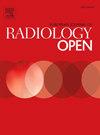MRI-based radiomics machine learning model to differentiate non-clear cell renal cell carcinoma from benign renal tumors
IF 2.9
Q3 RADIOLOGY, NUCLEAR MEDICINE & MEDICAL IMAGING
引用次数: 0
Abstract
Purpose
We aim to develop an MRI-based radiomics model to improve the accuracy of differentiating non-ccRCC from benign renal tumors preoperatively.
Methods
The retrospective study included 195 patients with pathologically confirmed renal tumors (134 non-ccRCCs and 61 benign renal tumors) who underwent preoperative renal mass protocol MRI examinations. The patients were divided into a training set (n = 136) and test set (n = 59). Simple t-test and the Least Absolute Shrink and Selection Operator (LASSO) were used to select the most valuable features and the rad-scores of them were calculated. The clinicoradiologic models, single-sequence radiomics models, multi-sequence radiomics models and combined models for differentiation were constructed with 2 classifiers (support vector machine (SVM), logistic regression (LR)) in the training set and used for differentiation in the test set. Ten-fold cross validation was applied to obtain the optimal hyperparameters of the models. The performances of the models were evaluated by the area under the receiver operating characteristic (ROC) curve (AUC). Delong’s test was performed to compare the performances of models.
Results
After univariate and multivariate logistic regression analysis, the independent risk factors to differentiate non-ccRCC from benign renal tumors were selected as follows: age, tumor region, hemorrhage, pseudocapsule and enhancement degree. Among the 14 machine learning classification models constructed, the combined model with LR has the highest efficiency in differentiating non-ccRCC from benign renal tumors. The AUC in the training set is 0.964, and the accuracy is 0.919. The AUC in the test set is 0.936, and the accuracy is 0.864.
Conclusion
The MRI-based radiomics machine learning is feasible to differentiate non-ccRCC from benign renal tumors, which could improve the accuracy of clinical diagnosis.
基于核磁共振成像的放射组学机器学习模型区分非透明细胞肾细胞癌和良性肾肿瘤
目的我们旨在开发一种基于 MRI 的放射组学模型,以提高术前区分非ccRCC 和良性肾肿瘤的准确性。方法这项回顾性研究纳入了 195 例经病理确诊的肾肿瘤患者(134 例非ccRCC 和 61 例良性肾肿瘤),他们都接受了术前肾肿块方案 MRI 检查。患者被分为训练集(136 人)和测试集(59 人)。采用简单的 t 检验和最小绝对值缩减和选择操作器(LASSO)来选择最有价值的特征,并计算其辐射分数。在训练集中使用两个分类器(支持向量机(SVM)和逻辑回归(LR))构建了临床放射学模型、单序列放射组学模型、多序列放射组学模型和用于分化的组合模型,并在测试集中用于分化。通过十倍交叉验证获得了模型的最佳超参数。模型的性能通过接收者操作特征曲线(ROC)下面积(AUC)进行评估。结果经过单变量和多变量逻辑回归分析,筛选出了区分非ccRCC和良性肾肿瘤的独立危险因素:年龄、肿瘤区域、出血、假包囊和增强程度。在构建的 14 个机器学习分类模型中,带 LR 的组合模型在区分非ccRCC 和良性肾肿瘤方面效率最高。训练集的 AUC 为 0.964,准确率为 0.919。结论 基于 MRI 的放射组学机器学习可以区分非ccRCC 和良性肾肿瘤,从而提高临床诊断的准确性。
本文章由计算机程序翻译,如有差异,请以英文原文为准。
求助全文
约1分钟内获得全文
求助全文
来源期刊

European Journal of Radiology Open
Medicine-Radiology, Nuclear Medicine and Imaging
CiteScore
4.10
自引率
5.00%
发文量
55
审稿时长
51 days
 求助内容:
求助内容: 应助结果提醒方式:
应助结果提醒方式:


